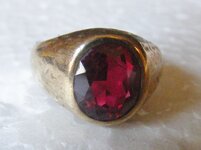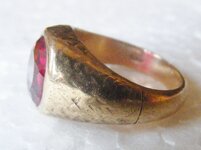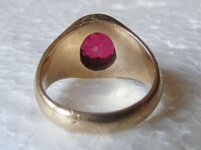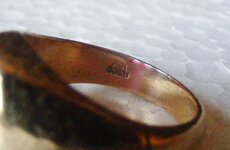Navigation
Install the app
How to install the app on iOS
Follow along with the video below to see how to install our site as a web app on your home screen.
Note: This feature may not be available in some browsers.
More options
You are using an out of date browser. It may not display this or other websites correctly.
You should upgrade or use an alternative browser.
You should upgrade or use an alternative browser.
Ruby Real or Fake?
- Thread starter CAllen
- Start date
Jim in Idaho
Silver Member
- Jul 21, 2012
- 3,349
- 4,750
- Detector(s) used
- White's GM2, GM3, DFX, Coinmaster, TDI-SL, GM24K, Falcon MD20, old Garrett Masterhunter BFO
'Way Too Cool' dual 18 Watt UV light
- Primary Interest:
- Prospecting
Two things to try. Ruby is corundum, and the 2nd hardest natural substance. (MOHS hardness 9.0) Try and scratch a piece of quartz with it. Quartz has a hardness of 7.0-7.5, so real ruby will scratch it. Also, ruby is very heavy...specific gravity is 3.9-4.1. If you're willing to remove the stone from it's setting, you can do a specific gravity test. Very few gems are heavier than ruby.
Jim
Jim
Upvote
0
arnofarrell
Hero Member
- Feb 18, 2012
- 805
- 264
- Detector(s) used
- Bounty Hunter
- Primary Interest:
- All Treasure Hunting
Thanks for that info. I have a red stone that was with some old coins and I have always wondered how to tell.
Upvote
0
Jim in Idaho
Silver Member
- Jul 21, 2012
- 3,349
- 4,750
- Detector(s) used
- White's GM2, GM3, DFX, Coinmaster, TDI-SL, GM24K, Falcon MD20, old Garrett Masterhunter BFO
'Way Too Cool' dual 18 Watt UV light
- Primary Interest:
- Prospecting
Good catch...I hadn't even considered a synthetic. I wonder how the SG compares in a synthetic? I also notice that spessartine garnets are close to corundum for specific gravity, though they have an orangish cast to the red color.
Jim
Jim
Upvote
0
Eu_citzen
Gold Member
- Sep 19, 2006
- 6,484
- 2,111
- Detector(s) used
- White's V3, Minelab Explorer II & XP Deus.
- Primary Interest:
- Prospecting
It seems to clean, that it threw me off, hence the suggestion of synthetic.
Synthetic ruby is still.. ruby, so SG is not diagnostic of a synthetic.
One needs a good microscope and experience to tell a synthetic from the natural counter part, even then one can make mistakes. (did you know the flux grown can look amazingly natural?)
Spessartites are also singly refractive, due to their cubic crystal structure.
A quick test under a polariscope should help eliminate that.
Synthetic ruby is still.. ruby, so SG is not diagnostic of a synthetic.

One needs a good microscope and experience to tell a synthetic from the natural counter part, even then one can make mistakes. (did you know the flux grown can look amazingly natural?)
Spessartites are also singly refractive, due to their cubic crystal structure.
A quick test under a polariscope should help eliminate that.
Upvote
0
StoneWhisper
Hero Member
my main concern is that what appears to be one thing, may in fact not be what you think.. if you follow.. I have had others ask this same question only to learn that what they thought was a buby was nothing more then a heat treated crystal or even a topaz..
Upvote
0
Bajahunter
Sr. Member
- Mar 26, 2011
- 265
- 107
Eu, if the SG is the same between a real ruby and a synthetic one, is the refraction index the same as well?
Almost everything I have read relates to how to ID a raw ruby, not one that has already been faceted. From what I understand measuring the refractive index involves measuring the speed of light as it passes through the stone. I wouldn't have a clue how that is done.
What other test would a gemologist do to ID this.
Almost everything I have read relates to how to ID a raw ruby, not one that has already been faceted. From what I understand measuring the refractive index involves measuring the speed of light as it passes through the stone. I wouldn't have a clue how that is done.
What other test would a gemologist do to ID this.
Upvote
0
luxefaire
Jr. Member
most times natural rubies will have inclusions within that the synthetics do not....i many times judge the possibility of real or synthetic by the mounting, its a good hint anyway. i dont like the 10k (Or is it 18k?), which is light quality for a ruby of that size and appearance, and the light color vs a darker....but i do like the style, it seems to be vintage perhaps. there are many good sources of gemological information on line, whole courses for free given by many authorities..it is an attractive stone one way or the other..b
Upvote
0
Eu_citzen
Gold Member
- Sep 19, 2006
- 6,484
- 2,111
- Detector(s) used
- White's V3, Minelab Explorer II & XP Deus.
- Primary Interest:
- Prospecting
Eu, if the SG is the same between a real ruby and a synthetic one, is the refraction index the same as well?
Almost everything I have read relates to how to ID a raw ruby, not one that has already been faceted. From what I understand measuring the refractive index involves measuring the speed of light as it passes through the stone. I wouldn't have a clue how that is done.
What other test would a gemologist do to ID this.
Yes, Refractive index would be the same. Synthetic ruby is EXACTLY the same thing as natural ruby, but lab grown.
It is measured on a refractometer.
Since it's set in a ring the tests one can do is limited. It's easier to ID a non mounted stone.
What tests they do depends on what they think it is, or if they are to do it "correctly".
If they are to do it correctly, then all possible tests are to be done. (i.e those which the setting does not disturb)
Upvote
0
StoneWhisper
Hero Member
After viewing the images again.. I feel its Synthetic or even plastic/glass in other words fake.. I guess I say this because my class ring (which was very simular to the above ring) didn't have a real sapphire in it..
Upvote
0
rodoconnor
Bronze Member
- Mar 4, 2012
- 1,419
- 1,639
- Primary Interest:
- All Treasure Hunting
how long have they been able to grow rubies?
Upvote
0
londog72
Jr. Member
- Jan 18, 2013
- 25
- 0
Yes, Refractive index would be the same. Synthetic ruby is EXACTLY the same thing as natural ruby, but lab grown.
It is measured on a refractometer.
Since it's set in a ring the tests one can do is limited. It's easier to ID a non mounted stone.
What tests they do depends on what they think it is, or if they are to do it "correctly".
If they are to do it correctly, then all possible tests are to be done. (i.e those which the setting does not disturb)
How u been? Maybe I misunderstood but when u said the grown are excatly the same as genuin did u mean regarding refraction or totaly? Because they are definately not totaly the same. Using a electron microscope the man made will have a uniform patern as genuin will never be "even" or have a patern. Would be like breaking car window glass with the pieces being all squar (man made) vs house glass that will break into many diff shapes and sizes. But I'm sure u ment the refractive qualities which I'm sure would be same. Correct me if I'm wrong because I've done some research but still learning. Thx for the refract info which I was unsure of..
Sent from my LGL75C using TreasureNet
Upvote
0
Eu_citzen
Gold Member
- Sep 19, 2006
- 6,484
- 2,111
- Detector(s) used
- White's V3, Minelab Explorer II & XP Deus.
- Primary Interest:
- Prospecting
LD,
All the functions that a gemmologist is generally concerned with will be the same.
Specific gravity, optical phenomena, refractive index etc etc.
It will have to be put under a microscope to look at the inclusions. (if there are any)
It will also have the same chemical make up as well as colourant as natural ruby.
In my book it's the same, ruby as ruby, right?
I haven't had the joy of playing with a EM so I can't say how it reacts.
All the functions that a gemmologist is generally concerned with will be the same.
Specific gravity, optical phenomena, refractive index etc etc.
It will have to be put under a microscope to look at the inclusions. (if there are any)
It will also have the same chemical make up as well as colourant as natural ruby.
In my book it's the same, ruby as ruby, right?

I haven't had the joy of playing with a EM so I can't say how it reacts.
Upvote
0
londog72
Jr. Member
- Jan 18, 2013
- 25
- 0
LD,
All the functions that a gemmologist is generally concerned with will be the same.
Specific gravity, optical phenomena, refractive index etc etc.
It will have to be put under a microscope to look at the inclusions. (if there are any)
It will also have the same chemical make up as well as colourant as natural ruby.
In my book it's the same, ruby as ruby, right?
I haven't had the joy of playing with a EM so I can't say how it reacts.
I have done research and saw pics of EM for both real and genuine and real has a pattern and can be manipulated where the atoms can be made closer for mor hardness. I read that they can take glass and make it harder than dimond. And cubics are normaly hard
Sent from my LGL75C using TreasureNet
Upvote
0
londog72
Jr. Member
- Jan 18, 2013
- 25
- 0
Oops got cut off lol.. anyway I also read that cubics are normaly harder due to there even makeup.. did u say u had a book out? If so then wow I had no idea. That's great. If u do and would tell me the name I would love to read it. Thanks again for all the info you have provided for me. Oh ya I forgot to tell ya the red ruby looking jem has a small area that fades to a yellowish color... if u know what that could mean it might help to identify. Haven't done SG test yet but will. Then if matches ruby then its probably that but if shows same as diamond then I'm off to a university to do em test for final proof. I'm not completley familiar with this site so if I have trouble finding u could u find me because I want to let you the so if u write another book u could add my story. Just the finding it to all the test and research have been an exciting adventure. I hope to hear from ya soon. Thx lonnie
Sent from my LGL75C using TreasureNet
Sent from my LGL75C using TreasureNet
Upvote
0
Top Member Reactions
-
 3339
3339 -
 1942
1942 -
 1925
1925 -
 1181
1181 -
 1093
1093 -
 895
895 -
 800
800 -
 800
800 -
 797
797 -
 785
785 -
 769
769 -
 531
531 -
 492
492 -
 459
459 -
 443
443 -
 425
425 -
 425
425 -
 420
420 -
E
412
-
 387
387
Users who are viewing this thread
Total: 2 (members: 0, guests: 2)






